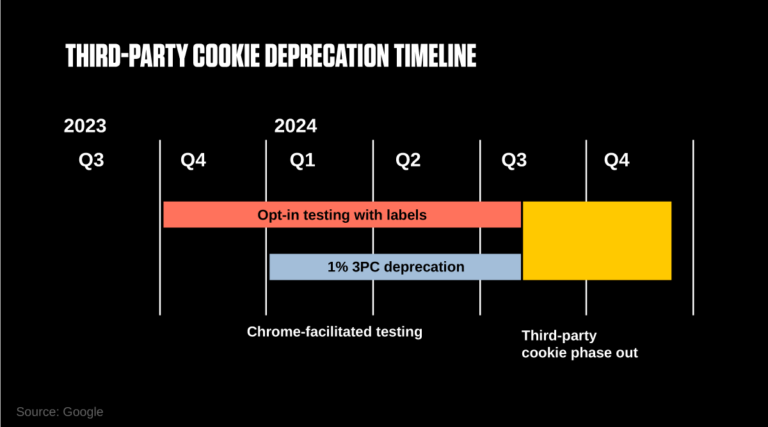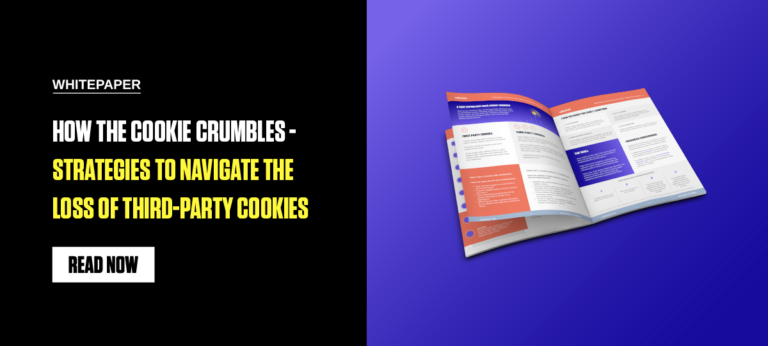The Digital Marketers Guide to Thriving in a Cookieless Future
Share:
January 4, 2024, will forever go down in digital marketing history as the start of a cookieless future. On that day, Google commenced the initial phase of removing third-party cookies, affecting approximately 30 million users worldwide.
While this milestone is anything but small potatoes, it’s not the first significant shift in digital marketing, and it won’t be the last.
As a media, analytics, and data agency, we understand the impact of losing third-party cookies. So, we’ve been busy strengthening our strategies and innovating our technology to stay ahead of the game. In fact, we’ve been prepping for this for a while now.
So join us in this comprehensive guide outlining how digital marketers like you can navigate this transition effectively across various channels, including paid search, paid social, and programmatic advertising.
- The Basics
- Our Foundation for Success in a Cookieless World
- Navigating Digital Paid Advertising Channels in a Cookieless World
THE BASICS
Before diving into all the details, let’s go back to the basics.
What are Cookies?
- An internet cookie, often simply referred to as a cookie, is a small piece of data stored on a user’s computer by a web browser while the user is browsing a website. Cookies are used to remember user-specific information and preferences, such as login credentials, shopping cart contents, and site preferences.
They serve various purposes, including enhancing user experience, tracking website usage, and personalizing content. Websites commonly utilize cookies for tasks like session management, user authentication, and tracking user behavior for analytics purposes.
Cookies fall into one of two camps: first-party data and third-party data.
What is First-Party Data?
- First-party data is user information that is collected directly from your audience and customers through interactions with your brand’s website, social media profiles, and other digital assets.
Whenever a user interacts with your owned channels, cookies are stored to track various details such as their shopping cart items, past purchases, and login credentials.
What is Third-Party Data?
- Third-party cookies are pieces of data that are created when a user visits websites other than your company’s website. That data is then stored in the users’ web browser and follows them as they continue to surf the web.
Digital marketers use these cookies to track users’ online activities across different websites, allowing advertisers to create detailed user behavior and preferences profiles.
This tracking enables the delivery of targeted ads that are more likely to be relevant to the user’s interests.
The Loss of Third-Party Cookies + Why It Matters
- Due to growing privacy concerns and changing personal data regulations, Google decided to phase out third-party cookies in the Chrome browser by mid-2024.
The loss of third-party cookies presents a significant challenge for digital marketing, impacting various crucial aspects of advertising strategies. Without these cookies, marketers face obstacles in targeting user behavior across different websites, hindering their ability to target specific audiences effectively and personalize ad campaigns.
This loss also complicates retargeting efforts, leading to potential decreases in conversion rates and ROI and making measuring campaign performance more challenging. Additionally, cross-device tracking becomes less reliable, impacting the consistency of advertising experiences across various devices.
The Importance of First-Party Data
- With the loss of third-party data, Google emphasizes the importance of first-party data as a critical path forward.
Unlike third-party data obtained from external sources, first-party data is inherently more trustworthy and compliant with privacy regulations because it is collected with user consent and originates from direct interactions.
As privacy regulations increase, the strategic value of first-party data rises, empowering businesses to maintain trust, comply with regulations, and deliver effective personalized marketing experiences in a privacy-conscious manner.
Our Foundation for Success in a Cookieless World
When approaching a cookieless future, remember “ACT”; audit your current process, connect 1st-party data, and test new strategies.
Audit:
- Assess How You Are Utilizing Third-Party Cookies:
- Look at how your company uses third-party data. Once you know better what channels, campaigns, and tactics rely on third-party cookies, you can begin transitioning and updating your strategies accordingly.
- Look at how your company uses third-party data. Once you know better what channels, campaigns, and tactics rely on third-party cookies, you can begin transitioning and updating your strategies accordingly.
- Diversify Your Marketing Mix:
- Are all your eggs in one basket? The omnichannel approach reduces reliance on any single platform or channel, mitigating the impact of losing third-party data by leveraging a comprehensive, full-funnel approach across various advertising channels.
This strategy enhances your ability to drive revenue through multiple touchpoints, ensuring more resilient and adaptable marketing efforts in a landscape without third-party data.
- Are all your eggs in one basket? The omnichannel approach reduces reliance on any single platform or channel, mitigating the impact of losing third-party data by leveraging a comprehensive, full-funnel approach across various advertising channels.
- Uphold Data Privacy Standards:
- Are you adhering to today’s data privacy standards? Prioritize transparency and compliance with international data privacy regulations, including GDPR and CCPA. By instituting precise opt-in mechanisms, we empower users to manage their data preferences, ensuring your brand maintains trust and respect for user privacy.
- Are you adhering to today’s data privacy standards? Prioritize transparency and compliance with international data privacy regulations, including GDPR and CCPA. By instituting precise opt-in mechanisms, we empower users to manage their data preferences, ensuring your brand maintains trust and respect for user privacy.
- Ensure Transparent Data Practices:
- Look for areas where you can educate users about data usage, offer them control over their personal information, and build a framework that respects their privacy choices at every digital touchpoint.
- Look for areas where you can educate users about data usage, offer them control over their personal information, and build a framework that respects their privacy choices at every digital touchpoint.
- Measuring Success:
- Now is the time to take a step back and reevaluate your metrics for success. How do your KPIs align with your overall business goals, and what is most important to ensure sustained growth?
- Now is the time to take a step back and reevaluate your metrics for success. How do your KPIs align with your overall business goals, and what is most important to ensure sustained growth?
Connect:
- Enhanced Customer Profiling:
- Utilize first-party data to create detailed customer profiles based on interactions with your website, app, or other owned channels.
This includes analyzing behavior, preferences, purchase history, and demographics. These insights can inform personalized marketing strategies and help serve relevant ads to specific audience segments.
- Utilize first-party data to create detailed customer profiles based on interactions with your website, app, or other owned channels.
- Lean into Solutions that Optimize Your First-Party Data:
- Whether you’re seeking marketing technology to streamline data organization, enhance optimization, or break down data silos, prioritize solutions specializing in first-party data.
Google’s solution to the demise of third-party cookies comes in the form of the Privacy Sandbox, designed to anonymize data for enhanced privacy and curb spam and fraud.
- Whether you’re seeking marketing technology to streamline data organization, enhance optimization, or break down data silos, prioritize solutions specializing in first-party data.
- Leverage Amazon and Retail Media Networks:
- If retail media networks are already part of your marketing mix, your brand is one step ahead in prioritizing first-party data. If not, you might want to consider adding it to the mix.
Amazon Advertising leverages the platform’s vast repository of first-party shopper data, inherently less dependent on third-party cookies. By tapping into Amazon’s detailed consumer insights, you can craft highly targeted advertising campaigns within its ecosystem.
This rich data source also offers valuable insights that can be applied across other channels, enhancing cross-channel marketing strategies with deeper understanding and precision in targeting.
- If retail media networks are already part of your marketing mix, your brand is one step ahead in prioritizing first-party data. If not, you might want to consider adding it to the mix.
Test:
- Simply put, the time to experiment is now. Build strategies resilient to future changes by experimenting with new attribution models and AI-driven campaigns while maintaining a continuous testing approach.
- With third-party cookie deprecation fully taking effect by the end of 2024, there’s no better time to adjust campaigns, test, and tweak to ensure a smooth transition when the phase-out officially happens.

Navigating Digital Paid Advertising Channels in a Cookieless World
Building on our foundational strategy emphasizing comprehensive data collection, privacy compliance, and advanced attribution, we will now go into detailed channel-specific approaches.
These tactics are designed to leverage the unique advantages of each channel, ensuring resilient marketing strategies thrive in a post-cookie digital ecosystem. Here’s how you can tailor strategies across various channels to navigate the challenges and seize the opportunities presented by the cookieless future.
Paid Search
Search Engine Marketing has gone through shifts before, and the loss of third-party cookies in Google Chrome won’t be the last. But if you are unsure of your next steps, here are a few strategies to stay ahead.
- Pair First-Party Data with AI-Driven Campaigns:
- Utilize Customer Match: First-party customer lists are an important signal for AI-driven products, such as Smart Bidding and optimized targeting. Leveraging high-quality, first-party data will help you maximize performance, especially with the deprecation of third-party cookies.
To make the most of this feature, remember to upload high-quality Customer Match lists to the audience library, apply the most relevant audiences to applicable campaigns, and refresh regularly (90 days or a timeline that incorporates your conversion cycle). - Harness AI and Automation with Google’s Performance Max (PMax). This technology incorporates your customer match data signals, and analyzes search data to identify the most effective keywords and conversion trends to automatically adjust your bids in real-time. Furthermore, PMax streamlines campaign management and incorporates key audience signals to maximize AI and help you meet your business goals.
- Utilize Customer Match: First-party customer lists are an important signal for AI-driven products, such as Smart Bidding and optimized targeting. Leveraging high-quality, first-party data will help you maximize performance, especially with the deprecation of third-party cookies.
- Increase Conversion Visibility with Google Enhanced Conversions
- Improve Conversion Measurement: Supported by both Google Ads and GA4, Enhanced Conversions protect against a cookieless future while providing sustainable measurement in a privacy-safe way.
- Consider BEACON for Enhanced Conversions: This technology facilitates the implementation of Enhanced Conversions in Google Ads via BigQuery and the Google Ads API, improving measurement accuracy with first-party customer data.
It is a privacy-first way to supplement existing conversion tags by sending hashed first-party conversion data, such as email address, name, home address, and or phone number, from a website to Google.
- GA4 Offers Additional Audience Measurement Opportunities
- Audience Activation in a Privacy-Centric Way: GA4’s Protected Audience API and Enhanced Conversions enable remarketing and improve conversion tracking accuracy using first-party data and AI-driven insights, all while ensuring compliance with privacy standards. In addition, activating User Provided Data (UPD) allows for additional audience insights and visibility for demographics and interests.
- By leveraging User Provided Data (UPD) and the Protected Audience API, you can benefit from GA4’s data for effective digital targeting and measurement, but you do risk lock-in as these tools require all data to be passed to Google via website tags only.

Paid Social
Social advertising has already had to navigate significant privacy changes, notably adapting to Apple’s iOS 14 update in 2021, which imposed restrictions on data tracking and app sharing. This development pushed social platforms to further harness their wealth of first-party user data, preparing them for the post-cookie era with less reliance on third-party data.
- Conversion API:
- By leveraging Meta’s Conversion API (CAPI), you can refine your digital advertising strategies without relying on third-party cookies.
This combination allows you to target Facebook and Instagram audience segments that are more likely to convert by informing bidding strategies and making systematic adjustments based on enriched signals and custom performance strategies directly fed back to Meta.
This respects user privacy and enhances ad relevance, engagement rates, and campaign outcomes by optimizing revenue, margin, and customer lifetime value, providing a comprehensive view of campaign performance across online and offline events.
- By leveraging Meta’s Conversion API (CAPI), you can refine your digital advertising strategies without relying on third-party cookies.
- Utilize AI-Based Campaigns:
- To navigate the challenges of third-party data deprecation, utilize AI-based campaigns, such as Advantage+ in Meta, to harness the vast first-party data in these platforms for precision targeting and optimization.
By leveraging these advanced AI algorithms, businesses can optimize ad delivery, personalize content, and efficiently reach their desired audiences, ensuring effective campaign performance in a cookieless landscape.
- To navigate the challenges of third-party data deprecation, utilize AI-based campaigns, such as Advantage+ in Meta, to harness the vast first-party data in these platforms for precision targeting and optimization.
- UTMs:
- UTMs provide a transparent way to track and attribute conversions to specific campaigns, channels, or ads. By appending UTMs to your social media links, you can precisely monitor the performance of your paid social campaigns, even without relying on third-party cookies.
Programmatic Advertising
The loss of third-party cookies definitely impacts programmatic advertising. However, contextual targeting and privacy-compliant ID solutions present viable alternatives.
- Contextual Targeting:
- Contextual advertising functions by aligning the content of a webpage with the content of an ad. Rather than relying on user data, this automated system showcases ads similar to the page’s content.”
By aligning ad messaging with the content that users actively engage with, contextual targeting ensures relevance and enhances the likelihood of user engagement without infringing on privacy.
- Contextual advertising functions by aligning the content of a webpage with the content of an ad. Rather than relying on user data, this automated system showcases ads similar to the page’s content.”
- Private Marketplace (PMPs):
- Advertisers can access premium ad spaces with greater control and transparency through private marketplace deals.
This direct negotiation with publishers secures more relevant and high-quality ad placements, offering a safeguarded environment for brand messaging in the evolving digital landscape.
- Advertisers can access premium ad spaces with greater control and transparency through private marketplace deals.
- Adopt Privacy-Safe ID Solutions:
- In response to the need for privacy-compliant targeting methods, adopting advanced ID solutions like Unified ID 2.0, ID5, or leveraging platforms like BlueKai and LiveRamp, provides alternative means of reaching audiences.
These solutions offer a way to maintain targeted advertising capabilities by using anonymized identifiers that respect user privacy, ensuring advertisers can continue delivering personalized web experiences.
- In response to the need for privacy-compliant targeting methods, adopting advanced ID solutions like Unified ID 2.0, ID5, or leveraging platforms like BlueKai and LiveRamp, provides alternative means of reaching audiences.
Charting the Course Together
As a media, analytics, and data agency with over 20 years of industry experience, we’ve been preparing for this day for a while.
As we embark on this journey, you can count on Adlucent as your partner. We pledge to navigate these changes alongside you through education, collaboration, and a commitment to strategic agility and technological innovation.
We aim to co-create strategies that align with your brand’s unique needs and set new benchmarks for success in a cookieless digital marketing landscape. The shift towards a cookieless future is inevitable, but with Adlucent by your side, it’s an opportunity to redefine the digital marketing paradigm.
The future is cookieless, but it’s bright with opportunity. Let’s prove outperformance has no limit.

Cara Ferguson
With over 19 years of experience, I am a seasoned expert in digital marketing, specializing in paid search, social advertising, programmatic, and retail media. At Adlucent, I lead the Practices team, driving innovation, setting industry standards and training the next generation of digital marketing experts. My leadership fosters a culture of excellence, collaboration, and continuous learning, contributing to Adlucent's status as a digital marketing powerhouse.
More Resources
Blog Post
January 9, 2025
Blog Post
October 9, 2024
10 Holiday Stats Every Retail Marketer Should Know
Discover 10 essential holiday shopping stats for retail marketers in 2024. Learn how to boost your campaigns with insights on omnichannel strategies, video ads, BNPL, and more."
Blog Post
September 5, 2024
Adlucent Awarded Google Marketing Platform Certified Partner Status, Strengthening Client Solutions
Adlucent, the performance media, analytics, and data agency that recently joined forces with BarkleyOKRP, is officially a Google Marketing Platform (GMP) Certified Partner for Display & Video 360 (DV360), Campaign Manager 360 (CM360), and Search Ads 360 (SA360).